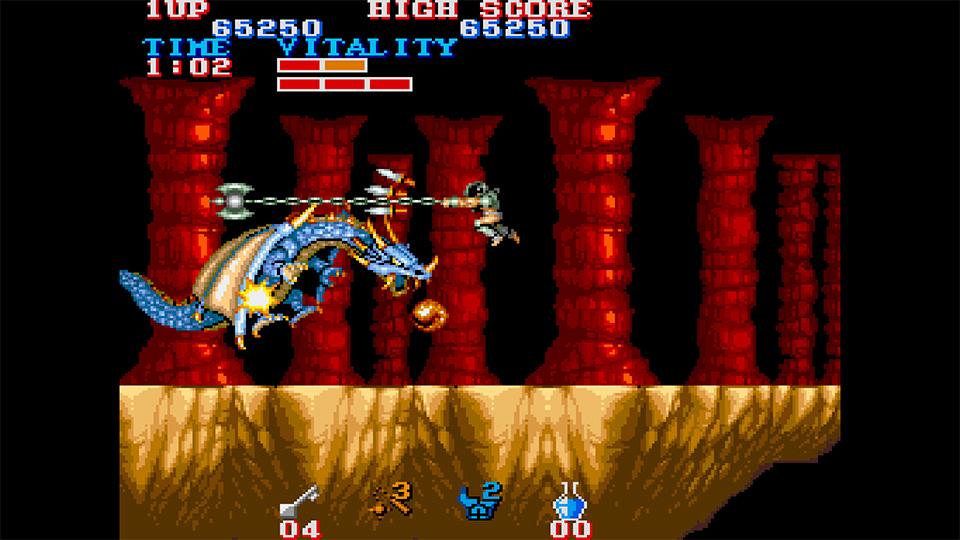TL;DR
Capcom Arcade 2nd Stadium packs 32 classic arcade gems, boasting a great lineup including Knights of the Round, The King of Dragons, and multiple Street Fighter titles. It offers a user-friendly emulator with handy features like save states and rewind, preserving the authentic arcade experience—even with original graphical quirks. While perfect for nostalgic fans and retro enthusiasts seeking a hassle-free way to relive the glory days of the arcade, its faithfulness to original limitations might not appeal to everyone. Ready to see if this collection is your ticket to retro gaming heaven? Read on for the full breakdown!
Following in the footsteps of Capcom Arcade Stadium, Capcom continues to deliver arcade classics to modern consoles and PC. Volume 2 presents a collection of 32 classic arcade games, featuring a strong selection of titles:
- 1943 Kai – Midway Kaisen –
- BLOCK BLOCK
- KNIGHTS OF THE ROUND
- MAGIC SWORD
- THE KING OF DRAGONS
- VAMPIRE SAVIOR – The Lord Of Vampire –
- BLACK TIGER
- Capcom Sports Club
- DARKSTALKERS – The Night Warriors –
- ECO FIGHTERS
- Gan Sumoku
- Hissatsu Buraiken
- HYPER DYNE SIDE ARMS
- HYPER STREET FIGHTER II – The Anniversary Edition –
- LAST DUEL
- MEGAMAN 2 – THE POWER FIGHTERS –
- MEGAMAN – THE POWER BATTLE –
- NIGHT WARRIORS – Darkstalkers’ Revenge –
- Pnickies
- Rally 2011 LED STORM
- SATURDAY NIGHT SLAM MASTERS
- SAVAGE BEES
- SONSON
- STREET FIGHTER
- STREET FIGHTER ALPHA 2
- STREET FIGHTER ALPHA 3
- Street Fighter Alpha – Warriors’ Dreams –
- SUPER GEM FIGHTER – MINI MIX –
- SUPER PUZZLE FIGHTER II TURBO
- The Speed Rumbler
- THREE WONDERS
- Tiger Road
The game selection is compelling, perhaps even more so than the first installment. The presence of multiple iterations of Street Fighter 2 and its sequels is unavoidable when discussing arcade games; however, given their overall quality (with the exception of the original Street Fighter), their inclusion represents a significant cultural achievement. Notable arcade favorites featured in this collection include Knights of the Round, The King of Dragons, Vampire Saviour, and Black Tiger, among others.
Capcom presents these arcade titles within a well-designed framework and emulator that feels both streamlined and intuitive. It incorporates familiar features expected from the genre, such as three save slots, a rewind function for correcting errors, CRT filters, and adjustable display perspectives. The inclusion of both English and Japanese ROM versions is a welcome touch, as these versions sometimes offer variations in content.

The collection’s loading screen indicates that it’s powered by the RE Engine (Resident Evil Engine), which seems somewhat excessive for emulating 30-year-old ROMs that can be run on contemporary smartphones. Capcom has opted to maintain a 1:1 recreation of the original arcade experience. Consequently, a gem like THREE WONDERS exhibits the same dropped frames and graphical anomalies that were present in the original arcade release. This design choice is questionable. While it technically delivers an accurate and preserved representation, it reinforces the notion that this collection caters primarily to nostalgics and those with an interest in gaming history. Frame drops and graphical glitches are rarely desirable; however, they were a limitation players learned to accommodate. Perhaps offering a refined version of these games with a smooth 60fps framerate, aligning with the presumed original creative intent constrained by the hardware of the time, would have broadened the appeal. Modern restorations of classic films, for example, don’t rely on degraded VHS tapes to recreate the original experience. Instead, they are often presented in UHD 4K, offering a revitalized viewing experience.
Capcom Arcade 2nd Stadium offers a solid compilation of arcade classics, providing a convenient way to build a retro gaming library on modern platforms without the need for complex emulator configurations or sourcing ROMs independently. Connecting a Capcom Home Arcade stick (which includes some of these games) to a PC as a two-player controller can deliver a nostalgic experience, particularly when playing Street Fighter with a friend. However, the collection remains niche, and it is uncertain whether new gamers will embrace it, considering the price point for a collection of 30 titles, some of which are of historical interest only (such as SONSON). Individual games can also be purchased separately for approximately 40 kronor each, which may appeal to those who already own titles from previous Capcom collections.
For those with a fondness for nostalgia, who spent countless hours and coins in arcades during the 80s and 90s, this collection will likely provide a rewarding reunion. Given that Capcom appears to be targeting this specific demographic, evaluating the product accordingly leads to a positive recommendation. The remaining question is how to efficiently organize these games and remember which titles belong to which anthology.
Capcom provided review copies for this evaluation. The provision of review materials does not influence our editorial independence. Our reviews are conducted independently, with our readers and consumers as our primary focus.

